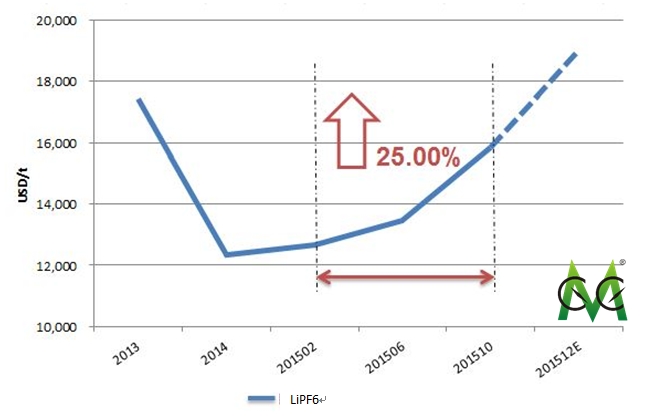The
price of LiPF6 is predicted to increase 50% in China next year due to the
increasing demand and its rising cost, according to analysts CCM.
The
LiPF6 segment has reversed the previous downturns since the beginning of 2015,
and has showed an upward trend in price. By October, the figure has reached
nearly USD15, 834/t, up by 25%, according to data from CCM.
Price
trend of LiPF6 in China, 2013-December 2015E

Source:
CCM
And
Stanley Wang, Chief Editor of China
Li-ion Battery News, predicts that the price of LiPF6 will even rise higher
in 2016:
“China’s
LiPF6 market would continue to grow” said Stanley, “The price is expected to
reach USD20, 585–23, 751/t. The upward trend in LiPF6 price is mainly
attributed to the increasing demand and the cost support.”
Why the price of
LiPF6 keeps rising since 2015?
CCM’s
research indicates that there are 2 main factors behind the recent surge in
LiPF6 price in China – the continuously explosive growth in China’s alternative
energy vehicle, and the increasing cost of one of its major raw material.
The explosive development
in EV boosts the LiPF6 market
The
alternative energy vehicle industry maintains the explosive growth in 2015,
largely pushing up the sales of the upstream- power Li-ion battery and the
battery’s materials like electrolyte, cathode materials and anode materials.
LiPF6,
as the major raw material of electrolyte, also boosts thanks to the great
development in the EV market. The increasing demand of LiPF6 explains why the
price keeps rising.
During
January-October 2015, China produced 181,225 alternative energy vehicles and
sold 171,145 ones, respectively up by 270% and 290% year on year, according to
statistics from the China Association of Automobile Manufacturers.
Such
a high speed growth in EV market is mainly ascribed to the highly concentrated
release and implementation of policies.
The
goal of the production and sales of EV is to be combined to reach 500,000 units
in 2015 and 5 million units in 2020, according to the Energy Saving and
Alternative Energy Vehicle Industry Development Planning (2012-2020) published
in July 9, 2012.
The
sales of alternative energy vehicle are required to account for 5% of the total
vehicle market in 2020, and to reach 20% in 2025, according to the policy of
Made in China 2025 published in May 2015.
However,
the production and sales would only surpass 400,000 units now. And during
January-October, the figure of the sales of alternative energy vehicle was only
0.89%, according to CCM.
“It
is still a long way to go for achieving the goal to produce and sell 5 million
units in total in 2020 and to reach figure, still needs great efforts”
commented Stanley.
“This
growth speed will last for several years, which will surely bring great
opportunities to the related industries” predicted Stanley, “As for its major
and important upstream material- LiPF6, the price may keep growing in 2016,
along with the boosting EV market.”
Lithium carbonate:
the cost of LiPF6 Raw material is rising
Lithium
carbonate, being LiPF6‘s major raw material, has increased in its price recently,
which causes the rising price in LiPF6.
The
globally leading lithium products supplier, FMC Corporation, up-regulated the
price of lithium carbonate by 15% worldwide from 1 October. This further drove
up the global upward trend.
The
average ex-works prices of battery grade lithium carbonate and industrial grade
lithium carbonate in China were about USD9, 062/t and USD7, 606/t respectively
in October, up by 39.59% and 20.08% over January, according to CCM.
The
reason why FMC up-grated the price is mainly attributed to the increasing costs
and decreasing supply of lithium carbonate.
FMC’s
production costs in the Hombre Muerto (salt lake, in Argentina, FMC's largest
lithium production base) rose largely.
During
July-September, the local financial conditions were worsening rapidly - the
galloping inflation (rate at 20%) and the exchange-rate control directly drove
up the production costs for FMC, according to CCM research.
In
addition, the rainy days in the “lithium triangle” (Argentina, Chile and
Bolivia) further caused the rise in cost and fall in output. In Q3, its supply
has decreased by 33% year on year.
To
cope with business crisis, FMC announced on 1 Aug. to up-regulate the prices of
lithium products worldwide, including 20% (= USD1, 000/t) for lithium
carbonate, lithium chloride and lithium hydroxide.
However,
the overall price up-regulations had not yet made up for the cost rises. In a
move to maintain the profit margin, FMC, in October, again raised up the
lithium products prices. Of this, those for lithium carbonate, lithium chloride
and lithium hydroxide were further up by 15%.
“Regarding
to the high supply concentration of lithium products and the shrinkage in its
output, the global supply will continue to be tight in the short run and the
price may keep growing” predicted Stanley.
“With
the increasing cost of LiPF6 raw material, the price of LiPF6 in China will
grow accordingly.” Stanley added.
We
will keep following up on the LiPF6 market in both our China
Li-ion Battery News and China Fluoride Materials Monthly Report.
About CCM:
CCM
is the leading market intelligence provider for China’s agriculture, chemicals,
food & ingredients and life science markets. Founded in 2001, CCM offers a range
of data and content solutions, from price and trade data to industry
newsletters and customized market research reports. Our clients include
Monsanto, DuPont, Shell, Bayer, and Syngenta. CCM is a brand of Kcomber Inc.
For
more information about CCM, please visit http://www.cnchemicals.com
or get in touch with us directly by emailing econtact@cnchemicals.com or calling
+86-20-37616606.
-
Average:3
-
Reads(2570)
-
Permalink


 Back to Cnchemicals.com
Back to Cnchemicals.com 